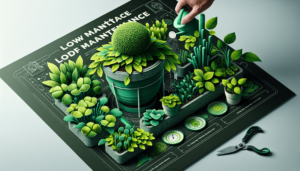Are you tired of dealing with waterlogged soil and root rot in your planter boxes? Look no further! This article will explore some effective drainage solutions for planter boxes that will help prevent these common gardening woes. Whether you’re a seasoned gardener or a novice plant enthusiast, these tips and techniques will ensure your plants thrive in well-drained soil, providing them with the ideal environment to flourish. Say goodbye to soggy roots and hello to healthy, vibrant plants in your planter boxes!
Importance of Drainage in Planter Boxes
Proper drainage is critical to plant health and survival in planter boxes. Without adequate drainage, water can accumulate in the soil, leading to saturated conditions that suffocate plant roots and promote the growth of harmful fungi and bacteria. By ensuring good drainage, we can prevent these issues and create an optimal environment for our plants to thrive.
Preventing waterlogged soil
Waterlogged soil occurs when there is excessive water in the planter box that cannot drain adequately. This can result in the roots being deprived of oxygen, leading to root rot and the plant’s eventual death. When the soil becomes waterlogged, it becomes compacted and loses its structure, making it difficult for roots to penetrate and absorb nutrients.
Promoting healthy root growth
Proper drainage is essential for encouraging healthy root growth in plants. When excess water drains out of the planter box, air can reach the roots, promoting oxygen exchange and preventing the roots from waterlogging. This, in turn, encourages the development of a robust root system that can efficiently absorb water and nutrients from the soil. Healthy root growth is essential for overall plant health and productivity.
Choosing the Right Planter Box Design
To ensure adequate drainage in planter boxes, it’s essential to consider the box’s design. Here are some factors to keep in mind when choosing a planter box:
Consider drainage holes
Drainage holes in the planter box are crucial for allowing excess water to escape. Without these holes, water can accumulate at the bottom, leading to saturated conditions. When selecting a planter box, choose one with multiple drainage holes evenly spaced at the bottom. This will help ensure that water drains out efficiently, preventing potential problems.
Opt for raised planter boxes.
Raised planter boxes are an excellent option for improving drainage. Raising planter boxes allows water to drain freely from the bottom by elevating the plants above ground level. This helps prevent waterlogging and ensures that the soil remains well-drained. Additionally, raised planter boxes can provide better aeration for the roots, leading to healthier plants overall.
Select the suitable material.
The material of the planter box can also affect its drainage capabilities. Some materials, like plastic or metal, may not provide adequate drainage. Consider adding drainage holes or lining the bottom with materials like landscape fabric to facilitate water drainage in such cases. Alternatively, opt for planter boxes made of porous materials such as wood or terra cotta, which naturally allow water to seep.
Using Drainage Materials
In addition to choosing the right planter box design, incorporating drainage materials can further improve water drainage efficiency. Here are two commonly used drainage materials:
Gravel or Pebbles
Adding a layer of gravel or pebbles at the bottom of the planter box can help create a drainage system. This layer allows excess water to flow freely through the soil, preventing it from becoming waterlogged. The gravel or pebbles provide adequate space for water to accumulate, preventing it from sitting directly at the bottom of the planter box. This is especially useful when drainage holes are not present or are insufficient.
Landscape Fabric
Landscape fabric is another valuable material for enhancing drainage in planter boxes. Placing a layer of landscape fabric over the drainage holes before filling the planter with soil helps prevent soil particles from clogging the holes. This ensures that water can flow freely while keeping the soil intact. Landscape fabric is particularly beneficial when using fine-textured soils prone to compaction.
Creating Drainage Holes
If your planter box does not come with pre-drilled drainage holes, you may need to create them yourself. Here are some important considerations when adding drainage holes:
Determining hole size and number
The size and number of drainage holes needed depend on the size of the planter box and the type of plants being grown. Generally, larger planter boxes should have more drainage holes to ensure adequate water flow. The holes should be large enough to allow water to escape freely but small enough to prevent excessive soil from escaping. A diameter of around 1/4 to 1/2 inch is usually sufficient for most planter boxes.
Preventing clogging
While drainage holes are essential for allowing water to escape, they can become clogged with soil particles or debris over time. To prevent this, consider placing a piece of landscape fabric or a small section of fine mesh over the drainage holes before adding soil. This will help keep the holes clear and prevent excessive soil from escaping while allowing water to drain efficiently.
Adding a Drainage Layer
In addition to drainage holes, incorporating a drainage layer at the bottom of the planter box can further enhance the drainage capabilities. Here’s how:
Creating a reservoir for excess water
A drainage layer is a reservoir for excess water, preventing it from saturating the soil and potentially drowning the roots. By creating this space at the bottom of the planter box, water can collect and drain away while leaving the upper layers of soil well-drained. This helps maintain a healthy moisture balance in the root zone and prevents waterlogging.
Using materials like perlite or vermiculite
To create a drainage layer, lightweight materials like perlite or vermiculite can be added at the bottom of the planter box. These materials have excellent water-draining properties and help create air pockets in the soil. Adding a layer of perlite or vermiculite about two inches thick ensures efficient drainage while providing adequate moisture retention for the roots.
Improving Drainage with Soil Amendments
Certain soil amendments can also improve the drainage capabilities of the planter box. Here are a couple of options:
Adding organic matter
Mixing organic matter such as compost or well-rotted manure into the soil can improve drainage by increasing soil porosity. Organic matter helps create a crumbly soil structure, allowing excess water to flow more efficiently. It also enhances soil fertility and provides essential nutrients to the plants. For optimal results, aim to add around 20-30% organic matter by volume.
Using coarse sand or pine bark fines
Incorporating coarse sand or pine bark fines into the soil can also improve drainage. These materials help loosen compacted soil and create channels for water to drain freely. However, it’s important to avoid using fine sand, as it can further exacerbate drainage issues by compacting the soil. Aim for a mixture of coarse sand or pine bark fines in appropriate proportions to promote optimal drainage.
Ensuring Proper Watering Techniques
Even with effective drainage solutions, proper watering techniques are crucial for maintaining a healthy environment for your plants. Here’s what you need to keep in mind:
Watering frequency
Watering frequency will depend on various factors such as plant species, climate, and soil type. It’s essential to balance providing enough water to keep the plants hydrated and preventing waterlogging. Generally, it’s better to water deeply but less frequently than lightly and often. This encourages the roots to grow deeper in search of water and helps maintain a well-drained soil profile.
Avoiding overwatering
Overwatering is a common mistake that can lead to drainage issues and negatively impact plant health. To prevent waterlogged conditions, it’s essential to allow the soil to dry slightly between waterings. Before watering again, check the moisture levels by inserting a finger or a moisture meter into the soil. If it feels damp or the meter indicates high moisture, hold off on watering until the soil can dry out.
Monitoring and Managing Drainage
To ensure optimal drainage, regularly monitoring the moisture levels in the planter box is necessary. Here are some tips for managing drainage effectively:
Checking soil moisture levels
Assess the moisture levels in the soil regularly to prevent overwatering or waterlogging. This can be done by inserting a finger or a moisture meter into the soil and checking for dampness. If the soil feels excessively wet to the touch or the meter indicates high moisture levels, it’s a sign that drainage may not be adequate, and adjustments may need to be made.
Adjusting drainage as needed
Sometimes, despite our best efforts, the drainage in planter boxes may not be sufficient. If you notice persistently damp soil or waterlogging issues, consider adjusting the drainage system. This may involve increasing the size or number of drainage holes, adding a layer of drainage material, or amending the soil mix with materials that enhance drainage. By monitoring and managing drainage, we can ensure a healthy plant-growing environment.
Maintaining Planter Box Drainage
Regular maintenance is crucial to ensure that the drainage system in planter boxes remains effective. Here are a few tasks to keep in mind:
Regularly cleaning drainage holes
Over time, drainage holes can become clogged with soil particles or debris, hampering the flow of water. It is essential to inspect and clean these holes regularly to maintain optimal drainage. Use a small brush or a toothpick to remove blockages, ensuring water can freely escape from the planter box.
Replacing or repairing damaged drainage materials
If you notice any damage or deterioration in the drainage materials, such as landscape fabric or drainage layers, it’s essential to replace or repair them promptly. Materials that become damaged or degraded may no longer provide adequate drainage, potentially leading to waterlogging issues. We can maintain optimal drainage in our planter boxes by ensuring the integrity of the drainage components.
Conclusion
Implementing effective drainage solutions in planter boxes is crucial for the health and longevity of plants. By considering factors such as drainage holes, planter box design, and appropriate materials, we can create an environment that promotes healthy root growth and prevents waterlogged soil. Incorporating additional drainage materials, creating drainage holes, and adding a drainage layer further enhance the drainage capabilities. We can ensure that our plants thrive in their planter boxes by using soil amendments, employing proper watering techniques, and regularly maintaining the drainage system. We can enjoy a vibrant and flourishing garden with optimal drainage in place.



